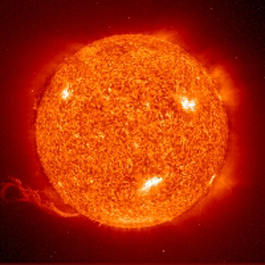Energy from the Sun
The sun has produced energy for billions of years. Solar energy is the sun’s rays (solar radiation) that reach the Earth. This energy can be converted into other forms of energy, such as heat and electricity.
In the 1830s, the British astronomer John Herschel famously used a solar thermal collector box (a device that absorbs sunlight to collect heat) to cook food during an expedition to Africa. Today, people use the sun's energy for lots of things.
Solar Energy Can Be Used for Heat and Electricity
When converted to thermal (or heat) energy, solar energy can be used to:
- Heat water — for use in homes, buildings, or swimming pools
- Heat spaces — inside homes, greenhouses, and other buildings
- Heat fluids — to high temperatures to operate a turbine to generate electricity
Solar energy can be converted to electricity in two ways:
- Photovoltaic (PV devices) or “solar cells” change sunlight directly into electricity. Individual PV cells are grouped into panels and arrays of panels that can be used in a wide range of applications ranging from single small cells that charge calculator and watch batteries, to systems that power single homes, to large power plants covering many acres.
-
Solar Thermal/Electric Power Plants generate electricity by concentrating solar energy to heat a fluid and produce steam that is used to power a generator. In 2010, solar thermal-power generating units were the main source of electricity at 13 power plants in the United States:
- 11 in California
- one in Arizona
- one in Nevada
In 2010, a 75 Megawatt solar thermal unit was added to Florida Power and Light's Martin plant, a 3,700 MW oil- and gas-fired facility. This innovative system uses a parabolic trough solar array to produce supplemental steam for use with an existing turbine/generator.
The main benefits of solar energy are:
- Solar energy systems do not produce air pollutants or carbon-dioxide
- When located on buildings, they have minimal impact on the environment
Two limitations of solar energy are:
- The amount of sunlight that arrives at the Earth's surface is not constant. It varies depending on location, time of day, time of year, and weather conditions.
- Because the sun doesn't deliver that much energy to any one place at any one time, a large surface area is required to collect the energy at a useful rate.




